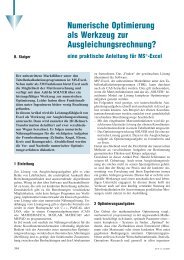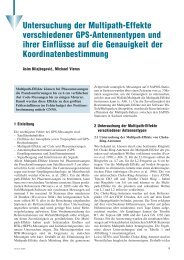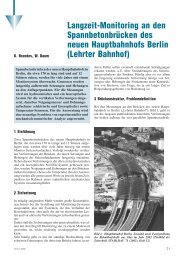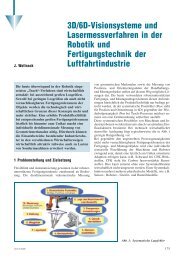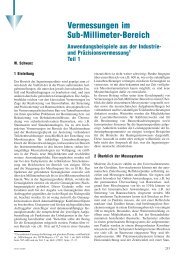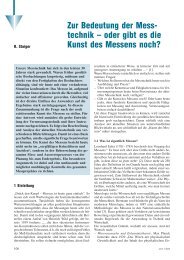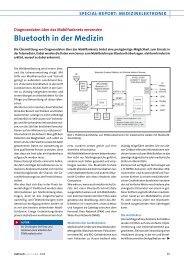Positioning Accuracy Standards for Geodetic Control
Positioning Accuracy Standards for Geodetic Control
Positioning Accuracy Standards for Geodetic Control
Create successful ePaper yourself
Turn your PDF publications into a flip-book with our unique Google optimized e-Paper software.
Fig. 7: The 95 % point and relative ellipses and confidence<br />
circles<br />
Tab. 1: Positional and Local uncertainty of horizontal<br />
coordinates (95 %)<br />
Station Type To Station Horizontal uncertainties<br />
(mm)<br />
1 Positional 13.8<br />
Local 2 0.7<br />
Local 3 0.9<br />
Local 4 1.2<br />
Local average 0.93<br />
2 Positional 12.9<br />
Local 1 0.7<br />
Local 3 0.9<br />
Local 4 1.2<br />
Local DT13 0.6<br />
Local average 0.85<br />
3 Positional 13.8<br />
Local 1 0.9<br />
Local 2 0.9<br />
Local 4 1.2<br />
Local DT55 0.7<br />
Local average 0.93<br />
4 Positional 16.4<br />
Local 1 1.2<br />
Local 2 1.2<br />
Local 3 1.2<br />
Local average 1.2<br />
R. Paar, G. Novakovic, E. Zulijani – <strong>Positioning</strong> <strong>Accuracy</strong> <strong>Standards</strong> <strong>for</strong> <strong>Geodetic</strong> <strong>Control</strong><br />
made of steel. The bridge is designed <strong>for</strong> road and pedestrian<br />
traffic. According to span dimension (100 – 300 m),<br />
this is a big bridge. There are two traffic and two pedestrian<br />
tracks, which are all together 10.5 m wide.<br />
For the bridge reconstruction, the local geodetic network<br />
was established. The network consists of six points<br />
(fig. 6), monumented as shown on figure 5. For surveying<br />
the network, Fast Static GPS method, in combination with<br />
triangulation and trilateration, was used. The heights were<br />
determined by precise differential levelling.<br />
In this paper, calculation of Positional and Local uncertainty<br />
of horizontal coordinates using only terrestrial<br />
data is presented. The survey was connected to existing<br />
control points DT13 and DT55 (fig. 7). During adjustment,<br />
datum values are weighted using one-sigma their Positional<br />
uncertainty. At first, results of a minimally constrained,<br />
least squares adjustment of the survey measurements<br />
are examined (using statistical tests) to ensure correct<br />
weighting of the observations and freedom of outlying<br />
observations (examination of the reliability). After<br />
that, Positional and Local uncertainties of the new points<br />
were determined (table 1).<br />
Point error ellipses were used to compute error circle radii<br />
<strong>for</strong> Positional uncertainty. Relative error ellipse values<br />
were used to compute error circle radii <strong>for</strong> Local uncertainty.<br />
The evaluation has been made from each point to<br />
all adjacent points regardless of the direct connections in<br />
the network.<br />
The calculation of Positional and Local Uncertainty of<br />
heights is identical to the method <strong>for</strong> calculation these values<br />
<strong>for</strong> horizontal coordinates, except that in stead 95 %<br />
confidence circles the 95 % confidence intervals are used.<br />
From the results, we can conclude that high absolute and<br />
relative precision of the established network were obtained.<br />
4 Conclusion<br />
The quality of geodetic control, which all works within<br />
some project are based on, influences directly the successful<br />
implementation of that project. The positioning precision,<br />
as one of the most important component of geodetic<br />
control quality, has been expressed in various ways depending<br />
on the positioning method. The standards have<br />
been referring to the precision of observations, and not<br />
to the coordinates of geodetic control points. These standards<br />
reflected the distance-dependant nature of terrestrial<br />
surveying error: Triangulation and Traverse – directly<br />
proportional to distance between points; differential levelling<br />
– directly proportional to square root of the distance;<br />
trigonometric levelling – directly proportional to distance<br />
between points and GPS – horizontal: base error<br />
þ directly proportional to distance between points<br />
at 95 % confidence level, vertical: directly proportional<br />
to distance between points.<br />
Since the usage of multiple standards makes the comparison<br />
of the accuracy of the points coordinates obtained<br />
with various measuring methods very difficult, unique<br />
standards have been established <strong>for</strong> expressing the spatial<br />
data accuracy, and they are defined by international stan-<br />
AVN 7/2009 285




